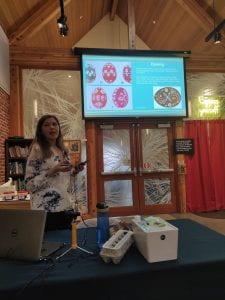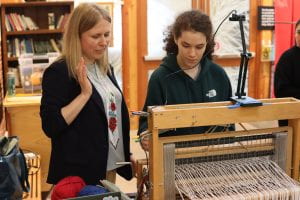From February to April 2023, OFN helped bring 6 Ukrainian artists to the University of Oregon campus, providing UO students and the larger Eugene community with an opportunity to learn about Ukrainian culture and its role in the current Ukrainian resistance towards Russian invasion. The series featured folksinger and traditional dancer Inna Kovtun, bandura player Valentyn Lysenko, pysanka artist Kristine Mushkevych, weaver Tetyana Horner, petrykivka artist Marina Malyarenko, and filmmaker and illustrator Sashko Danylenko. For many UO students and Eugene residents, the series presented a unique chance to discover both traditional and contemporary Ukrainian arts, which are often understudied in the US. For Ukrainians living in Eugene, these events became a place to reconnect with their culture and find other Ukrainians.

Kristine Mushkevych. Photo by Iryna Stavynska
OFN graduate employee Iryna Stavynska (from Ukraine), was the main organizer of the series, who credits the help of many others, including fellow OFN Graduate Employee Elise O’Brien (from the U.S.). Read on as they share their impressions of being involved in organizing the series.
Iryna Stavynska, Folklore MA student, Fulbright scholar from Ukraine & Graduate Employee at OFN:
“It was one of the most meaningful things that I got to do during my time in the U.S. For 2 years living in Eugene, I never saw any Ukrainian events, or any other opportunities to learn about Ukrainian arts. I did not feel like there were places where I could really be Ukrainian here – not fully. But until the full-scale Russian invasion in 2022, I never really thought about why things were this way. Seeing the war unfold, however, I realized that it was not a coincidence that Ukrainian culture is so underrepresented and understudied in the U.S. The same things that Russia is doing now – killing Ukrainians, occupying our land, and purposefully trying to destroy our culture by murdering Ukrainian artists, forcing Ukrainians to abandon our cultural practices and our language, and stealing and appropriating our heritage – it has done many times before, when Ukraine was part of Russian empire and USSR. For centuries, Russia has been an imperial power that was in the position to silence Ukrainian voices both through physical, brutal force and through cruel policies that forbade practicing Ukrainian language and culture. In the context of this centuries-long history of oppression, it is especially important that we recognize and amplify Ukrainian voices now. Events like this not only give much-needed support to Ukrainian artists (many of whom use their art as a way to raise awareness and fundraise in support of Ukraine), but also the very fact of uplifting Ukrainian culture is in itself an act of resistance, as it helps to sustain the very thing that Russia is trying to destroy – Ukrainian identity, culture, and dignity.”

Tetyana Horner. Photo by Iryna Stavynska
Elise O’Brien, Folklore MA student & Graduate Employee at OFN
Firstly, I want to thank Iryna so much for putting on this series and for having me involved in my small way. The series was impactful; I have learned so much from the Ukrainian artists who have presented. So much makes sense now after learning from Ukrainian personal experiences. In highlighting what I have learned, most importantly, I want to emphasize that folk art is an active resistance to imperialism and oppression.
I was able to attend and assist with three Ukrainian artist presentations: Tetyana Horner, a weaver, Marina Malyarenko, a petrykivka artist, and Sashko Danylenko, a filmmaker and illustrator. Their presentations covered historic folk-art traditions in Ukraine as well as their modern counterparts. They emphasized folk arts’ role in resisting imperialism. Imperial powers have three goals: to dehumanize the population they are invading, to destroy that population’s cultural heritage and identity, and to remove the connection of people with their landscapes. Because folk art is rooted in place, in connection with the landscape, and uses materials sourced from the landscape to create art and craft, the connection of people with place is also part of cultural identity. When you support folk arts and traditional knowledge you reinforce cultural heritage and unique identity, and in this way, you are also actively resisting imperialism. If the argument of legitimacy of Russian invasion is that Ukraine has no unique culture, Marina, Tetyana and Sashko are the counterargument.

Marina Malyarenko. Photo by Iryna Stravynska
Tetyana Horner and Marina Malyarenko practice weaving and petrykivka respectively, two Ukrainian folk art forms rooted in centuries of tradition. While, Marina started her floral painting traditional art form about 5 years prior to coming to the United States, Tetyana dove into Ukrainian weaving after moving to the US. I think it is important to highlight that Tetyana and Marina are both self-taught for much of their craft, finding instruction in related fields and through online study. Even without immediate access to traditional teachers, they have still become incredible traditional folk artists.

Sashko Danylenko. Photo by Iryna Stranvynska
Sashko Danylenko is more modern in his art. His presentation was centered on a series of comic book style illustrations featuring everyday Ukrainians who became extraordinary after the invasion of Ukraine by the Russian military. In his stories, he shared how ordinary people become folk heroes. He told the stories of the Ghost of Kyiv, the Witch of Konotop, a man surfing a Russian tank, and of a postal worker who shot down a fighter plane. He shared with the audience videos of ordinary Ukrainians that went viral: small acts of disrespect and resistance to Russian troops that created a cascading effect worldwide. At the JSMA presentation, Sashko’s prints of everyday heroes were available for sale along with t-shirts and totebags. Half of all his profits go to individuals and organizations in Ukraine.
Marina and Sashko are part of a creator’s collective organized to partner creatives in the U.S. with projects and organizations in Ukraine. These are projects that actively support Ukrainian resistance, support the people of Ukraine, and raise money for Ukrainian organizations. These projects range from illustrations for tactical medicine apps to auctioning off fine art. Sashko’s film work includes animations for children suffering from anxiety from the war.
Helping Iryna with her presentation of Ukrainian folk artists was the most informative and rewarding part of this school year.